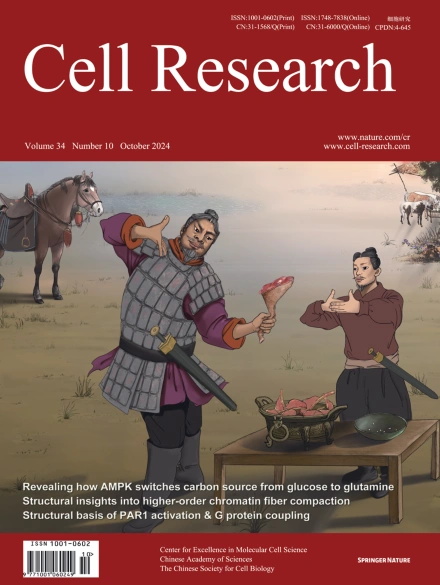
Advanced Search
Submit Manuscript
Advanced Search
Submit Manuscript
Volume 34, No 10, Oct 2024
ISSN: 1001-0602
EISSN: 1748-7838 2018
impact factor 17.848*
(Clarivate Analytics, 2019)
Volume 34 Issue 10, October 2024: 707-724 |
Structural basis for linker histone H5–nucleosome binding and chromatin fiber compaction
Wenyan Li1,2,† , Jie Hu1,2,† , Feng Song3,4,† , Juan Yu1,† , Xin Peng1,2 , Shuming Zhang5 , Lin Wang1,2 , Mingli Hu1,2 , Jia-Cheng Liu6 , Yu Wei1,2 , Xue Xiao1,7 , Yan Li1 , Dongyu Li1,2 , Hui Wang1,2 , Bing-Rui Zhou8 , Linchang Dai1,2 , Zongjun Mou1,2 , Min Zhou1 , Haonan Zhang1,2 , Zheng Zhou1,2 , Huidong Zhang9 , Yawen Bai8 , Jin-Qiu Zhou6 , Wei Li1,7 , Guohong Li1,2,3,* , Ping Zhu1,2,*
1Key Laboratory of Epigenetic Regulation and Intervention, Institute of Biophysics, Chinese Academy of Sciences, Beijing, ChinaThe hierarchical packaging of chromatin fibers plays a critical role in gene regulation. The 30-nm chromatin fibers, a central-level structure bridging nucleosomal arrays to higher-order organizations, function as the first level of transcriptional dormant chromatin. The dynamics of 30-nm chromatin fiber play a crucial role in biological processes related to DNA. Here, we report a 3.6-angstrom resolution cryogenic electron microscopy structure of H5-bound dodecanucleosome, i.e., the chromatin fiber reconstituted in the presence of linker histone H5, which shows a two-start left-handed double helical structure twisted by tetranucleosomal units. An atomic structural model of the H5-bound chromatin fiber, including an intact chromatosome, is built, which provides structural details of the full-length linker histone H5, including its N-terminal domain and an HMG-motif-like C-terminal domain. The chromatosome structure shows that H5 binds the nucleosome off-dyad through a three-contact mode in the chromatin fiber. More importantly, the H5-chromatin structure provides a fine molecular basis for the intra-tetranucleosomal and inter-tetranucleosomal interactions. In addition, we systematically validated the physiological functions and structural characteristics of the tetranucleosomal unit through a series of genetic and genomic studies in Saccharomyces cerevisiae and in vitro biophysical experiments. Furthermore, our structure reveals that multiple structural asymmetries of histone tails confer a polarity to the chromatin fiber. These findings provide structural and mechanistic insights into how a nucleosomal array folds into a higher-order chromatin fiber with a polarity in vitro and in vivo.
https://doi.org/10.1038/s41422-024-01009-z